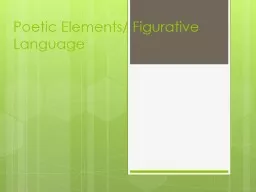

Poetry Review Random Disclaimer Although these elements are often found in poems thats not the only type of literature where they exist They could be in fictional stories nonfiction etc ID: 417926
Download Presentation The PPT/PDF document "Poetic Elements/ Figurative Language" is the property of its rightful owner. Permission is granted to download and print the materials on this web site for personal, non-commercial use only, and to display it on your personal computer provided you do not modify the materials and that you retain all copyright notices contained in the materials. By downloading content from our website, you accept the terms of this agreement.
Slide1
Poetic Elements/ Figurative LanguageSlide2
Poetry Review
Random Disclaimer:
Although these elements are
often
found in poems, that’s not the
only
type of literature where they exist. They could be in fictional stories, non-fiction, etc. Slide3
Figurative Language
Words used to create a special effect or description. These words don’t mean what they first appear to mean.
Figurative language makes writing interesting and unique.
The opposite of figurative language is
literal language
, which is saying EXACTLY what you mean. Slide4
Literal or Figurative?
1. She can run fast.
Literal. ↑
2. She can run as fast as a cheetah driving a Ferrari.
Figurative. ↑
Which way is more creative?Slide5
Simile
Simile – a comparison of two UNLIKE things using
like
or
as
.
Example:
“She is as bright as a star.”
What is this person trying to say about her?Slide6
Metaphor
Metaphor – comparison of two UNLIKE things NOT using
like
or
as
.
Example: “The teacher is a monster!”
What is this person trying to say about the teacher?Slide7
Extended Metaphor
Extended Metaphor- a comparison between two unlike things that continues throughout a series of sentences in a paragraph or lines in a poem. It is often comprised of more than one sentence and sometimes consists of a full paragraph.
Why is it difficult to provide a quick example of this?Slide8
Hyperbole
Hyperbole – an exaggeration in order to emphasize something.
Example:
“He is faster than lightning!”
Is he really faster than lightning?
What is this person trying to say about him?Slide9
Imagery
Imagery-using the 5 senses (touch, see, smell, hear, taste) in order to describe something.
Example:
“The bright blue ocean sparkled as the hot sunshine warmed the water. The salty smell of seaweed drifted into town.”
What is this person trying to show you?
What senses do these words appeal to?Slide10
Symbolism
Symbol- something concrete (can be touched) that represents something abstract (an idea).
Example:
“A heart represents love.”
Which word in the example is the “concrete” part of the symbol?
Which word in the example is the “abstract” part of the symbol?Slide11
Tone
Tone-how the author feels, or the emotion the author is trying to portray through his/her writing.
It’s not just what you say, it’s how you say it!
Example:
“I hate this stupid computer! I want to break it into a million pieces!”
What is the tone? How do you know?Slide12
Onomatopoeia
Onomatopoeia- words that sound like the sounds they are describing.
Example:
1. “The basketball swished through the net.”
2. “Squish. I stepped in mud!”
Which words in the above examples mimic the sound they are describing? Slide13
Alliteration
Alliteration- the repetition of sounds at the beginning of words that are near each other.
Example:
Carrie's cat clawed her couch, creating chaos.
What sound is repeated?Slide14
Rhyme
Rhyme- Two or more words that end with the same sound
Example:
1. “Mary had a little lamb,
His fleece was white as snow,
And everywhere that Mary went,
The lamb was sure to go.”
2. “teacher, bleacher, feature, creature, preacher”
Which words rhyme in the above examples?Slide15
Personification
Personification- giving human qualities to non-human things in order to better describe them.
Example:
“The trees danced in the wind as the sun smiled through the clouds.”
Which non-human things are being personified? How do you know?Slide16
Stanza
Stanza- poetry’s version of a paragraph. Authors can create them wherever they want. They can be any length or number of lines. This isn’t really a “poetic element,” but it is something you need to know in order to analyze and describe poems!
Example:
“I walked into the room
And found my friend there.
He looked really weird
Because he had no hair.”
How many stanzas are in this poem? How can you tell when one stanza ends and the other begins?Slide17
Theme!
Poems have themes, too!
What is a theme? Write your own definition (or look up the definition
from last week’s notes).